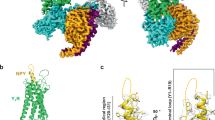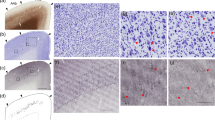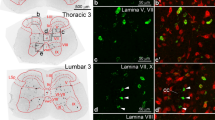Abstract
Tatemoto and Mutt recently used the presence of a C-terminal NH2 group to identify and isolate a new peptide, neuropeptide Y (NPY), from porcine brain1. This 36 amino acid peptide was subsequently shown to be active on isolated vas deferens, vascular smooth muscle and pancreatic acinar cells in very low molar concentrations2–4. In view of these potent effects we have now investigated its distribution in the human brain by radio-immunoassay and immunocytochemistry. High concentrations of NPY have been found, exceeding those of cholecystokinin and somatostatin, hitherto considered to be the most abundant neuropeptides. The distribution of NPY was different from that of any other peptide system described, being particularly concentrated in the basal ganglia, amygdala and nucleus accum-bens. Immunocytochemistry demonstrated a large number of NPY neuronal cell bodies especially in the caudate and puta-men. Immunoreactive neuronal cell bodies were also clearly localized in cortical areas, particularly layers V and VI. NPY, a newly discovered peptide with potent biological activity, thus seems to be among the most abundant of human neuropeptides. The massive numbers of NPY neurones in the basal ganglia suggest NPY to be of fundamental importance in the control of human motor function.
This is a preview of subscription content, access via your institution
Access options
Subscribe to this journal
Receive 51 print issues and online access
$199.00 per year
only $3.90 per issue
Buy this article
- Purchase on SpringerLink
- Instant access to full article PDF
Prices may be subject to local taxes which are calculated during checkout
Similar content being viewed by others
References
Tatemoto, K., Carlquist, M. & Mutt, V. Nature 296, 659–660 (1982).
Tatemoto, K. Proc. natn. Acad. Sci. U.S.A. 79, 5485–5489 (1982).
Lundberg, J. M. & Tatemoto, K. Eur. J. Pharmac. 83, 143–146 (1982).
Allen, J. M. et al. Neuropeptides 3, 71–77 (1982).
Roberts, G. W., Woodhams, P. L., Polak, J. M. & Crow, T. J. Neuroscience 7, 99–131 (1982).
Gu, J. et al. Lancet i 1008–1010 (1983).
Allen, Y. S. et al. Science 221, 877–879 (1983).
Kimmel, J. R., Hayden, L. J. & Pollock, H. G. J. biol. Chem. 250, 9369–9376 (1975).
Loren, I., Alumets, R., Hakanson, R. & Sundler, F. Cell Tissue Res. 200, 179–186 (1979).
Lundberg, J. M. et al. Acta physiol scand. 110, 107–109 (1980).
Hunt, S. P., Kelly, J. S., Emson, P. C. Kimmel, J. R. & Wu, J.-Y. Neuroscience 6, 1883–1898 (1981).
Vincent, S. R. et al. Nature 298, 65–67 (1982).
Vincent, S. R. et al. Neuroscience 7, 439–446 (1982).
Jacobowitz, D. M. & Olschawka, J. A. Peptides 3, 569–590 (1981).
Nakane, P. K. J. Histochem. Cytochem. 16, 557–560 (1968).
Ghatei, M. A. et al. Brain Res. (in the press).
Emson, P. C., Rehfeld, J. F. & Rosser, M. N. J. Neurochem. 38, 1177–1179 (1982).
Geola, F. L., Hershman, J. M., Warwick, R., Reeve, J. R. & Walsh, J. H. J. clin. Endocr. Metab. 53, 270–275 (1981).
Samson, W. K. in Vasoactive Intestinal Polypeptide (ed. Said, S. I.) 91–105 (Raven, New York, 1982).
Cooper, P. E., Fernstrom, M. H., Rorstad, O. P., Leeman, S. E. & Martin, J. B. Brain Res. 218, 219–232 (1981).
Author information
Authors and Affiliations
Rights and permissions
About this article
Cite this article
Adrian, T., Allen, J., Bloom, S. et al. Neuropeptide Y distribution in human brain. Nature 306, 584–586 (1983). https://doi.org/10.1038/306584a0
Received:
Accepted:
Issue Date:
DOI: https://doi.org/10.1038/306584a0
This article is cited by
-
Basolateral amygdala neuropeptide Y system modulates binge ethanol consumption
Neuropsychopharmacology (2024)
-
Combinatorial gene therapy for epilepsy: Gene sequence positioning and AAV serotype influence expression and inhibitory effect on seizures
Gene Therapy (2023)
-
Neuropeptides Modulate Feeding via the Dopamine Reward Pathway
Neurochemical Research (2023)
-
Potential gut–brain mechanisms behind adverse mental health outcomes of bariatric surgery
Nature Reviews Endocrinology (2021)
-
Neuropeptide Y and representation of salience in human nucleus accumbens
Neuropsychopharmacology (2019)



